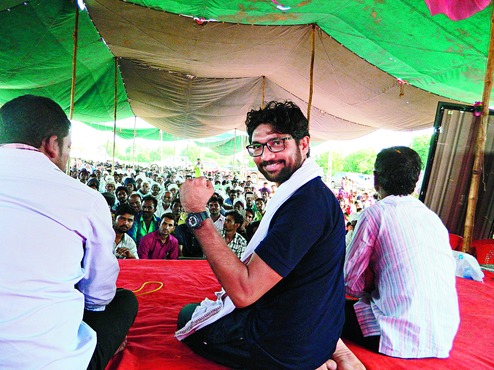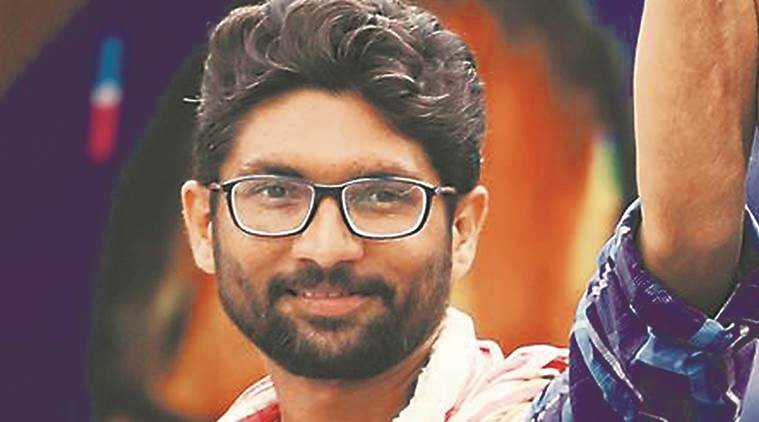

As Dalits Plant Flag of Self-Respect under Mevani Leadership, Families Get Back land promised since 1970s: Gujarat
The Battle for the Dalit Base: From the fields of Gujarat to the floor of Parliament
Its election year in Gujarat and the Dalits though numerically strong like Bengal have a seven per cent vote. Its also the month that NDA II under Modi is likely to install Ram Nath Kovind, a Dalit to the high office of President. In this context and political atmosphere, the Azaadi kooch yatra commemorating one year of the shameful Una public flogging of 5 Dalits assumed great significance. Jignesh Mevani, the lawyer-leader of the Rashtriya Dalit Adhikar Manch who led this yatra, planted the flag of self-respect on the land at Lavara in Banaskantha, land promised to Dalit families since the 1970s.
“If your chest is actually 56 inches, Modiji, then remove the dabang (strongmen)…. If you don’t, your BJP will be finished here…. Your Hindu nationalism is a fraud and it is our duty to expose those who kill peasants, workers and youths in the name of the cow,” Mevani told the cheering crowd at Lavara.
Sabrangindia had been among the first to focus on the land campaign led by Mevani over the years. “Land to the Dalit Tiller, not to Tycoons is our Mission: Jignesh Mevani” was a detailed interview with him on the issue (December 2016).
Keeping Mevani company on July 18, were Kantibhai Solanki, who was supposed to have been given possession of the land in the 1970s, and Dalpat Bhatia, who had taken up the cause of the Dalits in Lavara, a village in Gujarat’s Banaskantha district, 200km from Gandhinagar. Last Saturday, July 15, , Mevani, a 36-year-old lawyer, had issued an ultimatum that if the plots allotted to seven Dalits in Lavara in the 1970s under the Gujarat land ceiling law were not restored, 10,000 protesters would block the highway to Dhanera that branches out to Kandla Port and Rajasthan.
Clearly nervous with the agitation, on July 18, the district administration had restored the plots to two Dalits, one of who was Kantibhai. Today’s “takeover” would have largely been a token gesture devoid of tension but for one factor: Kantibhai complained that he was threatened by Kalusinh Vaghela, from whom the land was taken.
Vaghela belongs to the landed Darbar caste, categorised as part of the Other Backward Classes, while Kantibhai is a Dalit. The latent friction between the two – which need not mean they are openly hostile to each other – represents an undercurrent now at play in Gujarat and some northern Indian states.
As the symbolic march to claim back the promised land took place Mevani received a chit from the police present, in warning. Watched closely by about 2,000 Dalits, communists and Muslims, Mevani read the piece of paper that told him not to carry out a symbolic takeover of the land by planting blue Ambedkarite flags. Mevani, a fiery leader, did so anyway, after limiting the number of those who accompanied him to the plot. A large police force kept watch as Mevani marched through the freshly tilled soil in driving rain and hoisted an indigo blue flag featuring the Ashok Chakra and sporting the words “Jai Bhim”.
An FIR was also lodged against the threats received by the Dalit family prior to the protest event. The FIR was filed at Dhanera where around 2,500 people had gathered at the conclusion of Azadi Kooch, a march to commemorate one year of Una flogging incident. It was after this that the Dalits and rights activists led by Rashtriya Dalit Adhikar Manch leader Jignesh Mewani reached Lavara village, 12 km away, and planted blue flags on the 18-acre land.
“The district administration decided to start the process of returning the land a day before we were planning to forcibly take possession of the land. We take it as a positive sign and now we will make sure that this happens all over Gujarat. On August 15, we will gather at Soneth village in Banaskantha and ensure that Dalits there get their land back,” said Mewani. “We also give the state administration time till December 6, which is Babasaheb Ambedkar’s death anniversary, to make sure that land allotment for Dalits takes place. If not then over 50,000 Dalits will congregate and forcibly take possession of the land,” he added.
The Dalits call it a battle for self-respect – and Mevani is part of a new breed of leaders tapping into the discontent that is also fuelled by rising aspirations. If Mevani makes inroads into the state’s consciousness, a casualty could be the broader “Hindu umbrella” that the Sangh parivar and Narendra Modi are seeking to unfurl.
It was only after the sustained protests under Mevani that these land claims were met. For years, the battle has been within the Courts in Gujarat but there have been no positive gains for Dalits despite Court orders in their favour.
Speaking to the media, Solankibhai, who got the land back, said: “My father had fought for this land since the 1970s. The Darbars wouldn’t part with it. Now we are better off and my brother is a postman. We are not ignorant of our rights. Last year, I complained to the tehsildar. Not a single official came until Jigneshbhai’s Azadi Kooch started. Yesterday the tehsildar came, made us sign some paper and gave us possession of the land. Kalubhai challenged me that he would never allow me to farm here.” Before this moment of empowerment, the Solankis were mere sharecroppers on the same land, growing jowar and bajra and giving Vaghela a fourth of the produce as rent.
Dalits are the most populous in this village, with about 100 households, followed by the dominant Darbars who have 80 families.
The Vaghela household, spread over more than an acre in several concrete dwellings, overlooks the fields. A worker loading grain in Vaghela’s godown said he wasn’t home.Kalusinh’s brother Brahmarsinh Vaghela, a former sarpanch, said: “Yes, my brother held the land but the Dalits were the sharecroppers. There is no question of any conflict. But it is sad that the police had to come to our village for the first time in my memory. There has never been any caste clash here.”
What makes Mevani strike a chord with young Dalits? Vipul Parmar, a computer operator who was part of the land takeover, said: “I had not heard of Jigneshbhai until a week back and was attracted by the posts on social media. He seems to be the only leader in Gujarat who is talking about the Dalits. I am in this land movement not because I want to do farming but because it is about self-respect. Even if Ram Nath Kovind (the NDA candidate) becomes President and comes here, the Thakurs will make him sit in a corner. Dalits who watch the news now know that the BJP is a Manuvadi party that silently hates us and makes us clash with Muslims.”
For Lakshmiben Maharia who came all the way from Ahmedabad to support the Azadi Kooch march it was the gender issue that found resonance. “I joined Jigneshbhai when he came to our village and explained that wearing a ghunghat (veil) is outdated and an unhealthy tradition. Despite anger from elders, all of us women stopped wearing the ghunghat. Land is important but we educate families with drunkard husbands (despite prohibition in the state) not to waste money they will gain from land on liquor. We won’t allow any man from our community to beat his wife if he is drunk.”
The agitation will not end here. In Banaskantha’s Sonheth village, Mevani has announced an agitation to help 63 Dalit families whose allotted land has been under the occupation of of dominant castes. There is some potential for conflict as claims and counter-claims ensue.
Related Articles:
1. If the Cow is Your Mother, You Bury Her: Gujarat Dalits Cry Liberation
2. The Nation Does Not Need the Gujarat Model: Jignesh Mevani
